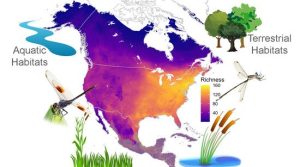
A new paper in Diversity, authored by a team of international collaborators that was headed up by Dr. John Abbott (Director of The University of Alabama’s Department of Museum Research and Collections) and Dr. Cornelio Bota Sierra (Postdoctoral Research, The University of Alabama Museums) about the Diversity of Nearctic Dragonflies and Damselflies has been published.
Rarely have studies assessed Odonata diversity for the entire Nearctic realm by including Canada, the United States, and Mexico. For the first time, we explored Odonata diversity in this region according to a definition of natural community assemblages and generated species distribution models (SDMs). Species occurrence data were assembled by reviewing databases of specimens held by significant Odonata repositories and through an extensive search of literature references. Species were categorized as forest-dependent or non-forest-dependent, as lentic or lotic-dependent, and according to conservation status. Predicted distributions were stacked for all species across their entire ranges, including areas outside of the Nearctic. Species richness and corrected weighted endemism (CWE) were then calculated for each grid cell. We found a pattern of greater species richness in the eastern portion of the Nearctic, which can be explained by the higher aquatic habitat diversity at micro and macroscales east of the Rocky Mountains, promoting niche partitioning and specialization. In the Nearctic region, the southeastern US has the highest number of endemic species of dragonflies and damselflies; this degree of endemism is likely due to glacial refuges providing a foundation for the evolution of a rich and unique biota.